More sustainable than commercial toothpaste, tooth powders effectively clean your teeth. They’re simple to make, help save you money, and by making your own, you control the ingredients.
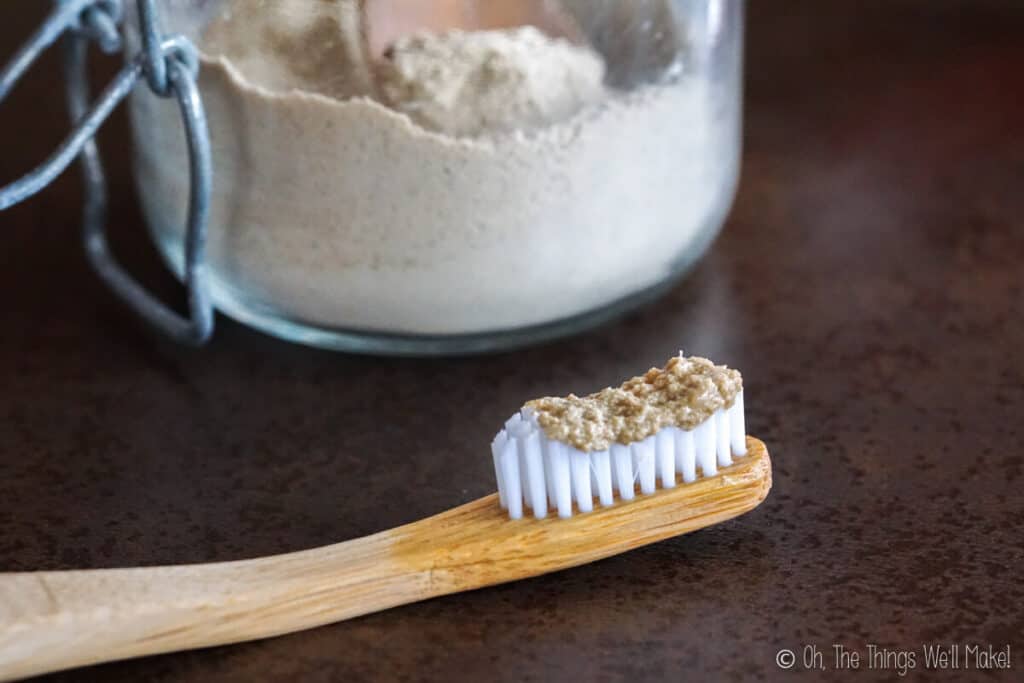
Table of contents
For many years now, I’ve been brushing my own teeth with a variety of homemade toothpastes. For some reason, though, I put off trying to make or use a tooth powder until more recently.
Perhaps I thought it would be uncomfortable to use. (It isn’t.) Or maybe I thought it would feel grainy and unpleasant. (It doesn’t.)
When my naturopath gifted me a tooth powder to try out towards the end of last year (and, yes, she knew my history of being a dentist), I decided it was time to test it.
I used it until I ran out and have to admit that I was pleasantly surprised by how much I liked it. I wanted to make more.
So, when I met Kelly Hancock, RDH of Toothbrush Life, around that time, I thought it would be fun to challenge her to make a tooth powder for my readers. It’s something I’ve been meaning to do for a while now.
She jumped at the opportunity and quickly sent over a recipe and an article to share with you. I made it myself and have to say I love it! I have since customized the recipe and will give you my thoughts and ideas for customizations. First, though, let me leave you with Kelly’s article…
Why make your own toothpaste powder?
It’s important to know what you put in your body. If you make your own toothpaste powder, you will stay in control of all of the ingredients used.
Avoid toxic ingredients
No extra stuff, no fluff, no extra additives or harmful chemicals.
There are some chemicals in regular over-the-counter toothpaste that have been deemed harmful and cause many people health issues.
SLS
One common ingredient that people often have reactions to is SLS, or sodium lauryl sulfate. This is a surfactant or synthetic detergent. It’s what makes your toothpaste foam up. It can also cause tissue sloughing and mouth ulcers.
Triclosan
Another toxic ingredient sometimes included in commercial toothpaste is Triclosan. Triclosan, a bactericide, has been linked to concerns over antibiotic resistance. It is also an endocrine disruptor that has been shown to affect thyroid function and impair muscle function (including that of the heart).
FDA stance on triclosan
The FDA no longer allows for the use of triclosan in most home care products like hand soaps. They do, however, allow it in toothpaste, despite the studies that show its negative health implications, because it has been shown to improve gingivitis in some patients.
Are you willing to risk your health to maybe slightly improve gingivitis? (When you can make changes in your oral care to improve gingivitis without those health risks?)
More sustainable
If you make your own toothpaste powder, not only will you have a safer toothpaste, but you will also be helping the environment.
Think of how many tubes of toothpaste you go through in a year. Tooth powder can be stored in a glass jar. No more plastic waste.
Save money
Once you’ve bought the inexpensive ingredients needed for making toothpaste, you can make many batches. That means you can save a lot of money over buying commercial toothpaste or tooth powder.
Tracy’s comment
Another great reason to make a homemade tooth powder is that there is no need to add a preservative. It has a very long shelf life. There is no need to worry about microbial growth. (This is the main concern when making a homemade water-based toothpaste.)
Because no water is added, no preservative is needed. (You can read more about when and why to use preservatives in my beginner’s guide to natural preservatives.)
Be careful not to contaminate the tooth powder with water when using it.
To keep the toothpowder contaminant-free, consider spooning up a small amount of the powder onto a clean spoon and loading it onto your brush from there. Using a damp toothbrush, rather than a dripping wet one, may also help.
Ingredients
Making your own tooth powder is simple and doesn’t require a lot of ingredients.
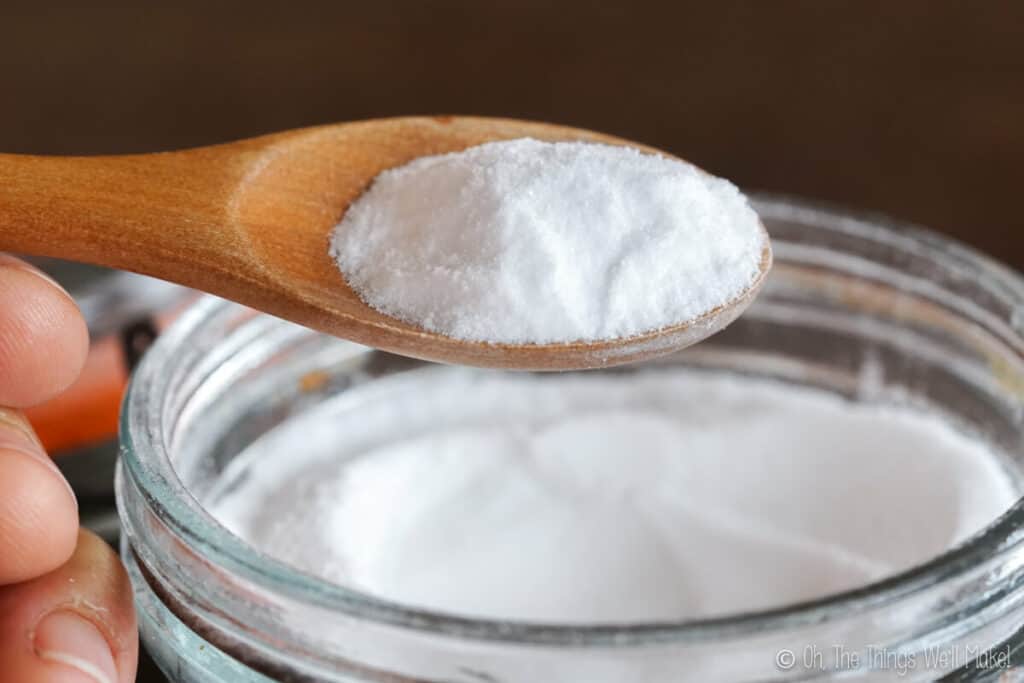
Baking soda
Baking soda breaks up stain molecules, helping to lift stains off of the teeth. That makes it an effective cleanser and natural teeth whitener. It also neutralizes the pH in the mouth which helps prevent tooth decay.
You may have heard that baking soda is really abrasive and damaging to teeth, but that is completely false. Baking soda is actually the second-lowest of the tooth cleansers that have been evaluated on the RDA scale.
What is the RDA Scale?
The RDA scale, or relative dentin abrasion scale, is a tool used to help dentists and patients know how abrasive different tooth powders or toothpastes are.
Baking soda’s RDA value is only 7 on a scale of 0-250. 0-70 is understood as low abrasive and 151-250 is regarded as harmful. The only thing with a lower abrasive rating on the RDA scale is plain water on a toothbrush.
Baking soda’s low abrasiveness and ability to clean the teeth so well make it a great ingredient for homemade toothpaste or toothpowders.
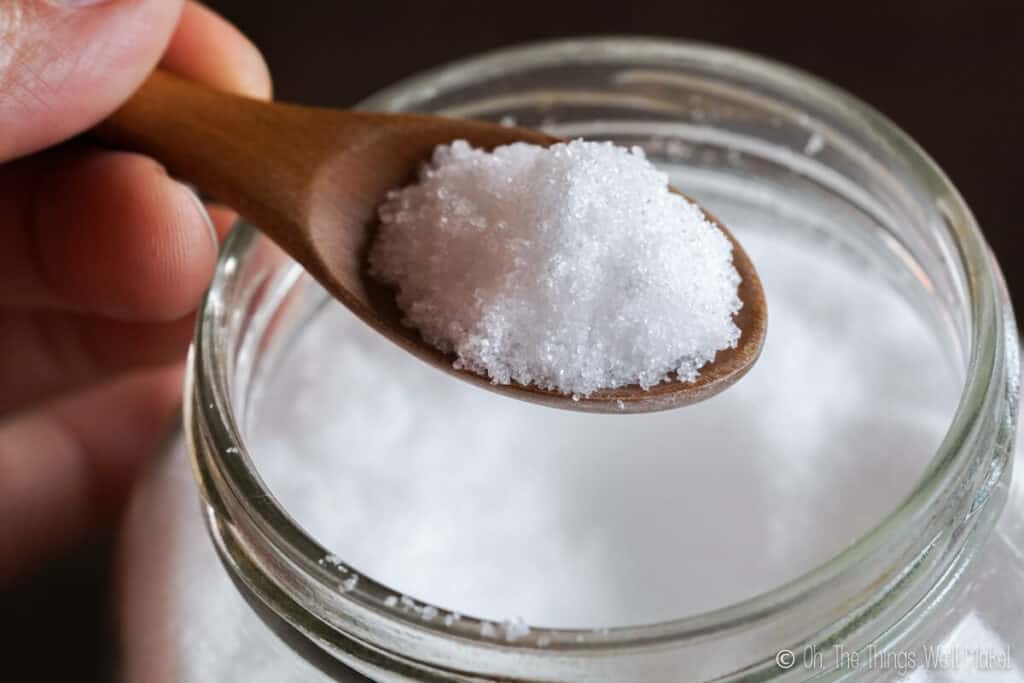
Xylitol
Xylitol is a natural sweetener. Other sweeteners that are added to commercial toothpaste have been shown to have negative side effects.
Xylitol has been shown to prevent cavities and is an ingredient in many sugar-free chewing gums. Xylitol is also great for neutralizing the pH in the mouth. This results in a less acidic environment helping to prevent tooth decay.
This is what we will use to sweeten our toothpaste (with the bonus that it has great oral health benefits).
Xylitol Warning
While xylitol is the perfect choice for sweetening homemade toothpaste and tooth powder for humans, it is toxic to dogs and cats. (And, perhaps, some other animals.)
Do not use it on your pets and keep it out of their reach!
Essential oils
Not only do essential oils have therapeutic benefits, but they can also provide a great fresh taste as well.
Adding essential oils is completely optional, but does add flavor to the powder.
Consider adding oils like peppermint or spearmint for a minty flavor and fresh mouth feeling. Clove oil is another popular essential oil for oral care products.
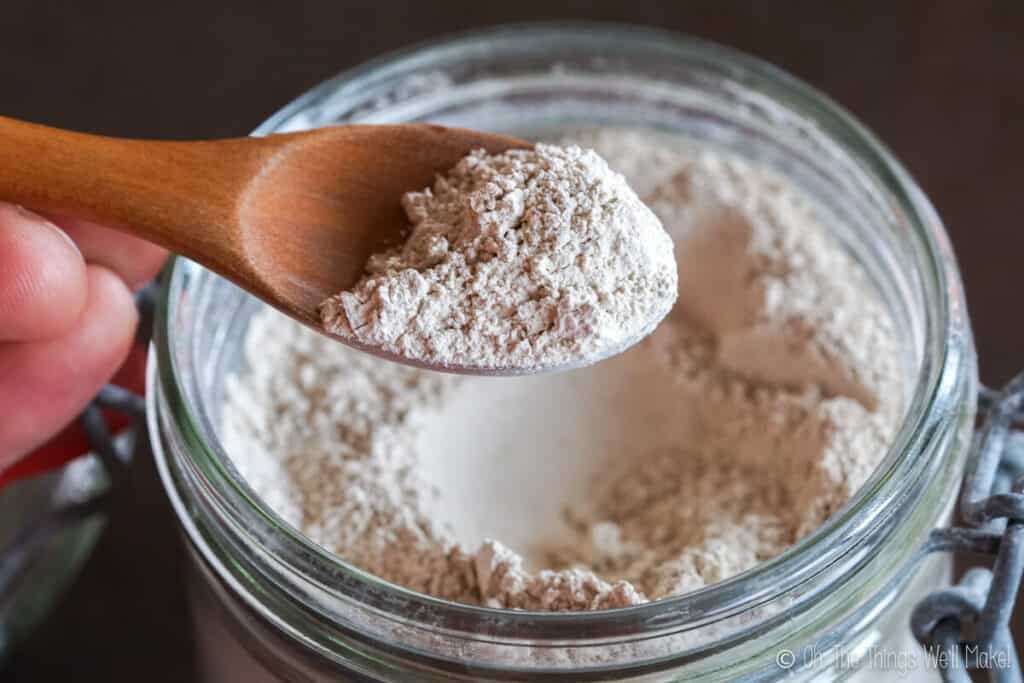
Bentonite clay
Bentonite clay is claimed to help draw out toxins. It also has lots of minerals that may help remineralize teeth.
How to use tooth powder
To use the toothpaste powder simply add a little bit to a damp toothbrush and brush as usual. Ideally, brush your teeth two times a day for at least two minutes.
You may follow up with a homemade mouthwash, if desired.
Video
Recipe
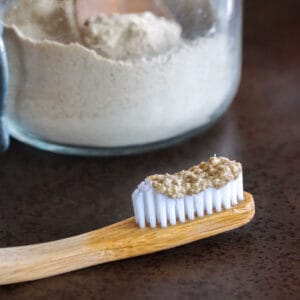
DIY Tooth Powder
Materials
- 3 Tbsp. Bentonite Clay
- 3 Tbsp. Baking soda
- 2 Tbsp. Xylitol
- 5 drops essential oils like mint or spearmint optional, for flavor
Instructions
- Mix all of the ingredients in a glass jar with a wooden spoon.
- To use the toothpaste powder, simply add some to a wet toothbrush and brush as usual.
Notes
Back to Tracy Ariza, DDS…
Customizing the recipe
I tested the recipe as written, using a few drops of mint essential oil, and I loved it.
Still, I thought it would be fun to test other combinations.
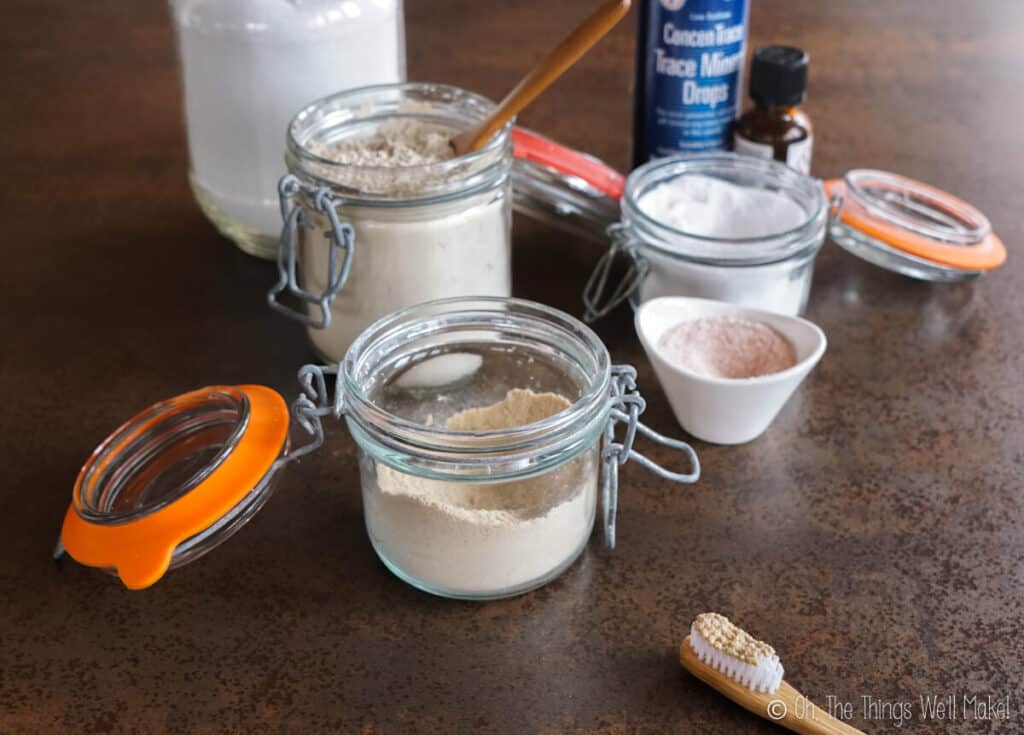
Mineral drops
Mineral drops add, well, minerals to the powder, of course.
Cavities are a type of demineralization of the teeth that happens in the presence of acids formed by bacteria in dental plaque. So, it goes to reason that having a variety of minerals around the teeth (in combination with a higher pH environment) may help with remineralization. That would help prevent cavities.
Because mineral drops are a water-based ingredient, you’ll want to add only a small amount to the baking soda and allow the liquid to evaporate before adding the other ingredients.
(When water is introduced into a product, it promotes microbial growth. We want to avoid that to have a shelf-stable product that doesn’t need any preservatives.)
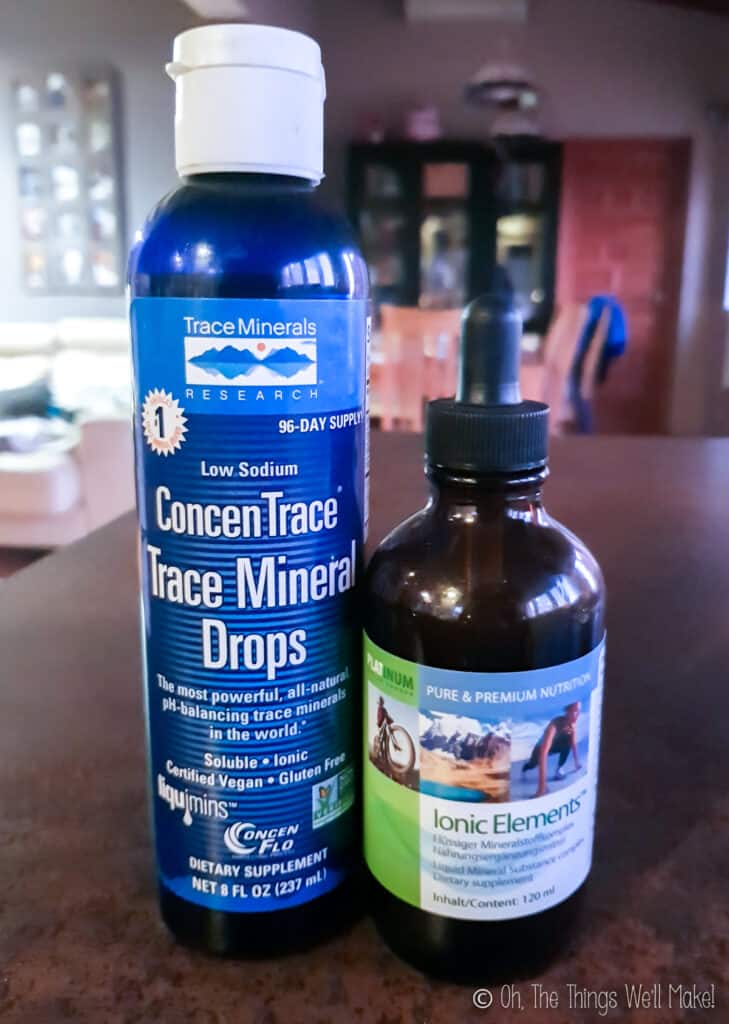
Ionic Elements
One of my favorite trace mineral products is Ionic Elements by Purium (in the USA) and by Platinum Health here in Europe.
Discount Code
If you want to get $50 off Ionic Elements or any other Purium products order of $75 or more, click on the link to their website and use the code: keephealthywithtracy
(I recommend copying and pasting the code to avoid any issues.) This code will get you either $50 off or 25% off- whichever is more!
If you decide you love it and stick with using their products, you will automatically be considered a “loyal customer” after your first order and will continue to be able to buy at a discounted rate. As long as you order every month, you will save 25% on your purchases. You’ll also start to earn Rewards Points. If you forget to order one month, you’ll receive a 15% discount instead. To get back to receiving a discount of 25% off, make sure you order within 30 days of your last purchase.
ConcenTrace
Another trace element product I have used and like is called ConcenTrace by Trace Minerals Research. I ordered through Amazon in the past, but I can no longer find that particular product there anymore. They do have a product called Endure which provides minerals meant to be used as electrolytes for maximizing athletic performance.
Salt
Salt will add a different flavor to the tooth powder, but that’s not the main reason for adding it.
Salt is known to help promote healing and soothe inflammation, making it an ideal addition to toothpaste.
If you use a salt like Himalayan salt, you are also providing extra essential trace minerals. They may help with remineralization of the teeth.
Activated charcoal
Many people have asked my thoughts on adding activated charcoal to homemade toothpaste or tooth powder.
While it does show potential whitening effects, it also may be overly abrasive. Because activated charcoal can vary so much from product to product, it’s difficult to determine an overall abrasiveness rating.
In my opinion, there just isn’t enough evidence to suggest enough potential benefits that outweigh the risk of using it in a homemade toothpaste on a daily basis. (Commerical products that use charcoal may be able to more carefully monitor the abrasiveness of their product in a way that we can’t effectively do at home.)
Kelly agrees and has written a post on her blog with her thoughts on using charcoal toothpaste.
Final thoughts
Making your own toothpaste powder can be extremely beneficial to your oral care routine. The ingredients are natural, safe and better for the environment.
Have you tried using tooth powder yet?
 Español
Español
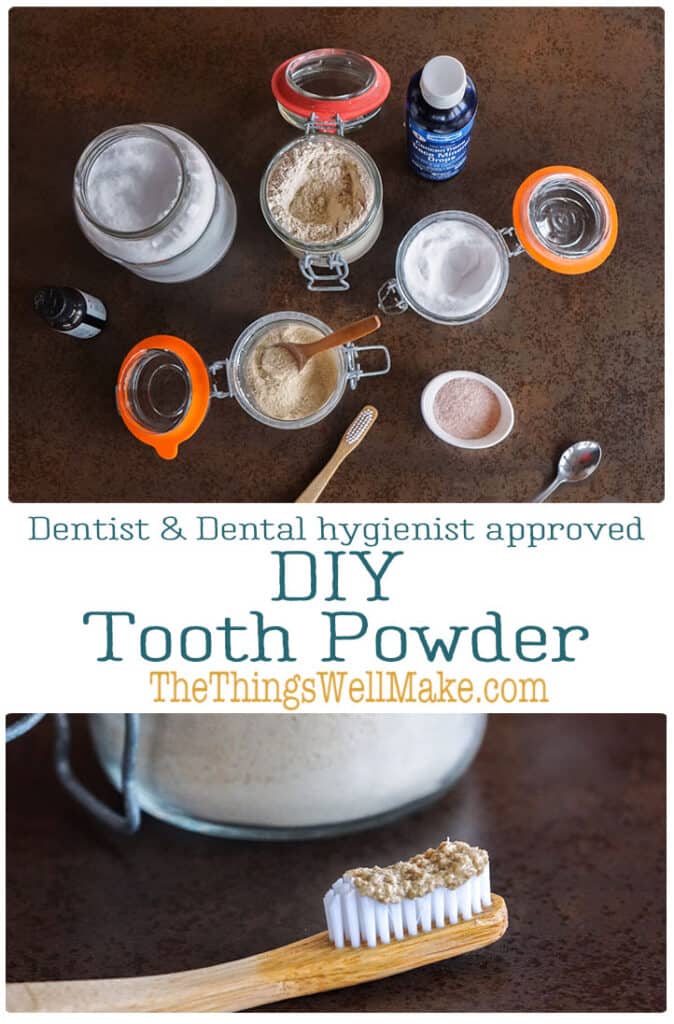
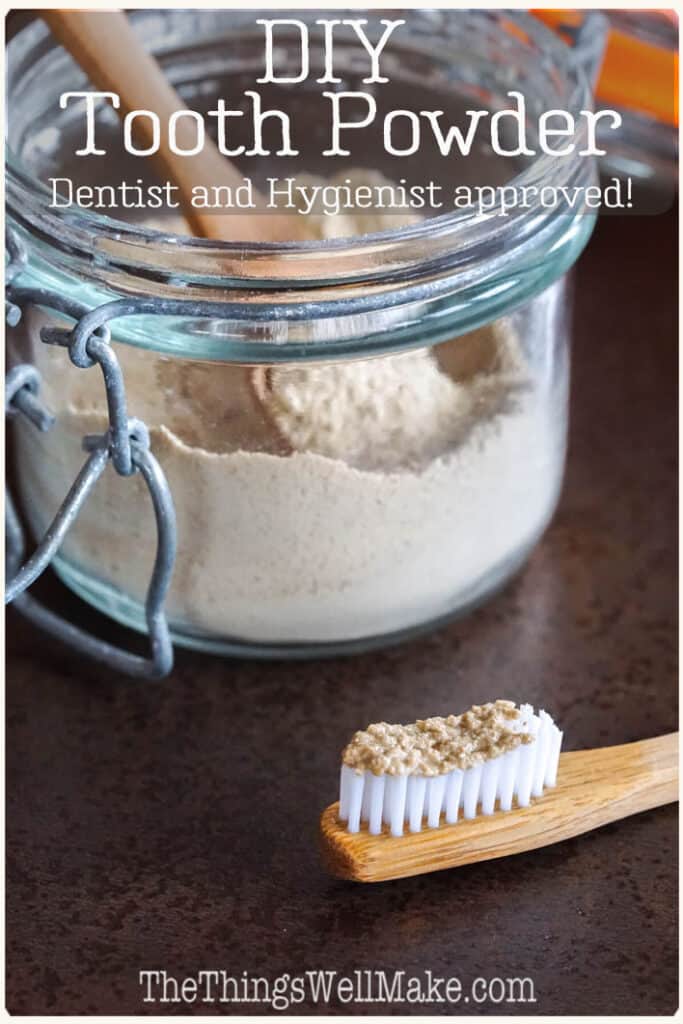
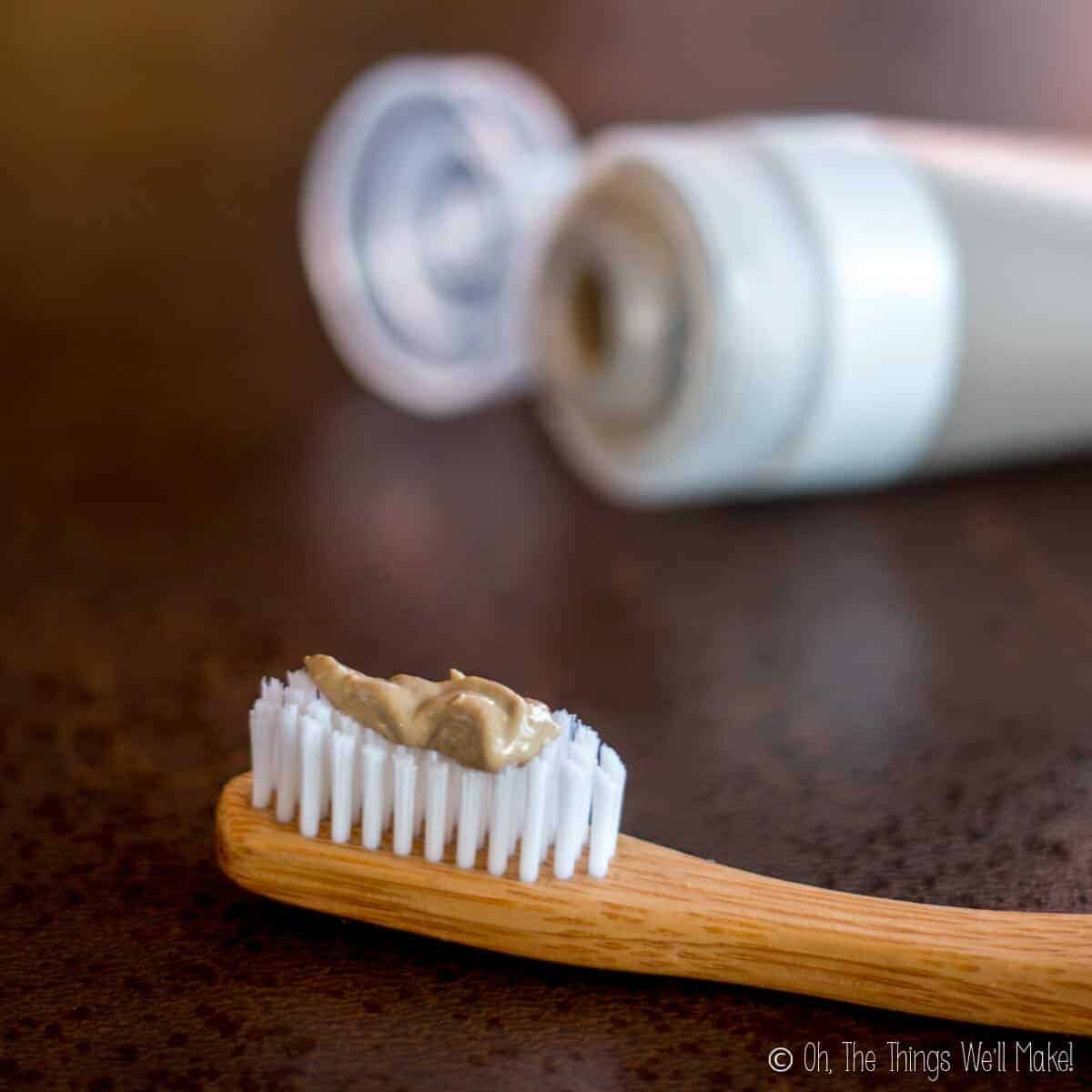
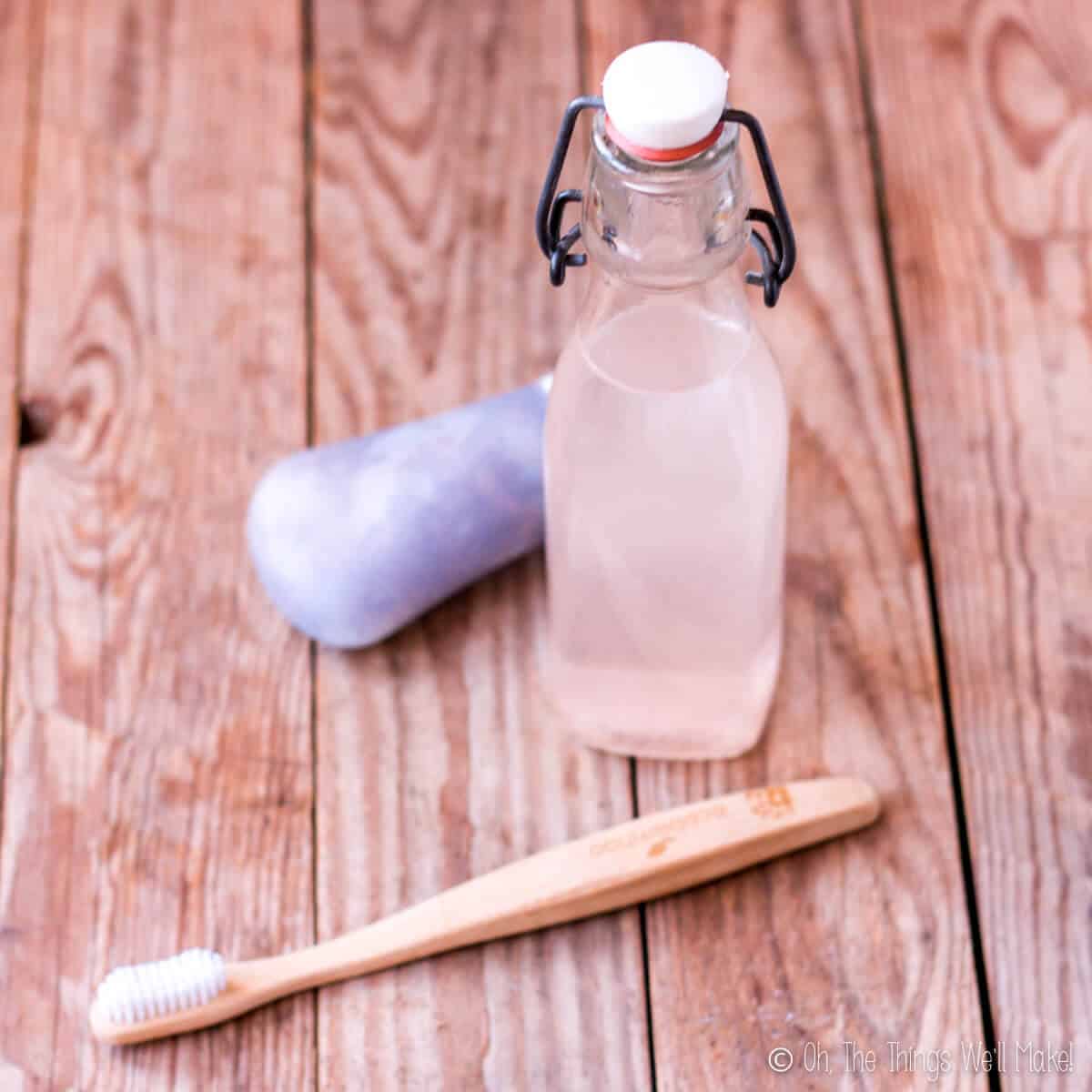
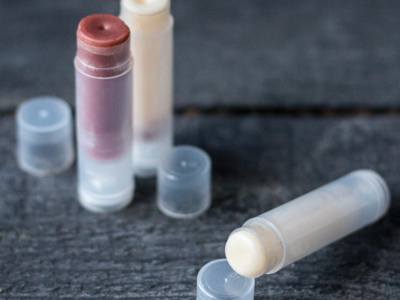
 Basic Pasta Dough Recipe
Basic Pasta Dough Recipe
Tracy Phelan
I just made your tooth powder and then started looking at what the internet had to say about it. This guy https://www.healthline.com/health/tooth-powder#pros-and-cons listed the pros and cons. Most of his cons for tooth powder I don’t agree on, but what are your thoughts on the ADA not awarding their seal of acceptance for tooth powder. Thanks.
Tracy Ariza, DDS
Hi Tracy,
The ADA will only put their seal on toothpastes (which would include any sort of tooth cleansing products) that include fluoride.
As tooth powders don’t include fluoride, it makes sense that the ADA hasn’t applied their seal to any.
I’m of the opinion that fluoride is not necessary in toothpastes (and powders). I haven’t used fluoride in years and haven’t had issues. My (almost 11-year-old) son has never used fluoridated toothpaste and we don’t have fluoridated water here either, and he’s never had a cavity.
Cavity formation will be based more on what you eat and other factors than what is in your toothpaste. That said, if you are very cavity-prone, you may be more cautious about ditching fluoride.
Silvia Fuente
Hola Tracy.
Acabo de descubrir tu blog y me encanta ?
Poco a poco he ido cambiando mis hábitos y creando mis propias cremas y champús porque he descubierto que es lo mejor en mi caso.
Hace años que utilizo un dentífrico en polvo porque leí acerca de ciertos ingredientes de las pastas convencionales (incluida la glicerina).Sus ingredientes principales son carbonato de calcio y xilitol.
En la tabla de la ¿RDA? el bicarbonato de sodio tiene un índice de abrasión de 7, ¿sabes cuál es el índice del carbonato de calcio?¿Hay algo negativo del carbonato de calcio?¿Son mejores las arcillas?
Si logro encontrar la arcilla de bentonita (en el enlace sale como no disponible) mi próximo proyecto será tu polvo dental.
Muchísimas gracias por tu generosidad a la hora de compartir tu sabiduría y conocimientos. ?
Tracy Ariza, DDS
Hola Silvia,
Gracias!
No sé dónde cae al carbonato de calcio en la tabla de la RDA. El las tablas que he visto, sólo hay el bicarbonato y después son pastas ya hechas con muchos ingredientes. De todas formas, me imagino que será poco abrasivo.
En realidad, a veces uso una pasta con carbonato de calcio y también he hecho versiones caseras. Esta semana planeaba trabajar en eso ya que me acababa de llegar unos ingedientes que quería usar, pero me he distraido con otros proyectos (mi marido quería un nuevo jabón de afeitar que hace una espuma más cremosa) y tendra que esperar hasta la semana que viene si no puedo hacerlo mañana. (De todas formas siempre uso las cosas que hgo durante unas semanas, por lo menos, antes de publicar las recetas.)
Las arcillas son más fáciles de encontrar en los EEUU, creo y había una pasta de dientes natual bastante famosa allí y por eso empecé con las arcillas. (Tambiñen lo tenía ya para hacer mascarillas para el rostro.)
A mi me parece genial usar el carbonato de calcio y puede que de una sensación mejor- ya que parece más a las pastas de dientes “normales”. 😉
Tom Carbone
Hi Tracy. I just happened to find your website/blog about toothpaste and tooth powder. I own a company, Natural Tooth Health, that has been making and selling hydroxyapatite based paste and powder. We are EWG Verified to use only nontoxic ingredients .
I would love to send you samples to try.
We have been growing our business over the last 3 years, and have been getting great results. I included a copy of our last company Newsletter which highlights 4 recent customer results.
Please let me know if you are interested in trying our products. Thanks Tom Carbone
Natural Tooth Health is very proud to have received numerous emails in the last few months thanking us for our products. The following emails for your review also highlight the tremendous results our customers see by using our products.
Subject: A miracle?
Message: Dear Tom, I just wanted to let you know about my last dental appointment. Upon my yearly exam my dentist spotted a very small cavity she wanted to fill. I made an appointment to come back in 2-1/2 weeks to have it done. In the meantime, I had just received my tooth powder and paste order from you. I had never used either before. I used both types alternatively, paying special attention to that spot, sometimes coating it with the powder and letting it be in contact with the area as long as possible. I had read some amazing things about hydroxyapatite and had high hopes. I couldn’t believe it when I went back to have the cavity filled, the dentist couldn’t find it! She checked and rechecked, and looked at the X-ray again. She seemed a bit baffled and assumed she just made a mistake. I told her I had been using a toothpaste with hydroxyapatite, but she didn’t seem interested. Is such a “miracle” even possible? For the compound to heal a tiny cavity in such a short time? I don’t know but whatever happened, I’m grateful! Even if she did make a mistake l did notice my gums began to look less receeded, less red, and had a better appearance overall. I think the SLS and/or silica in regular toothpastes may have been irritating my gums and I didn’t know it. Thank you so very much for your product. I think your formula ingredients are spot on and my teeth and gums and general health are the better for it! Jeannie Oklahoma
_________________________
Hi Tom.
I just wanted to let you know that I placed an order for the tooth powder in bulk and wanted it with peppermint flavor and without baking soda like you made for me last time.
My kids really liked it without baking soda.
Also, I have good news that I want to share with you. One of my sons was told that he had a small cavity on his enamel. After that, we started using your tooth powder, and at his most recent visit, we were told that the cavity is gone!
It seems like your tooth powder is working for us.
Have a wonderful Labor Day weekend!
Tamiko
________________________
Mr, Carbone,
By the way, I absolutely love your toothpaste. I tell everyone I can about it because it has been wonderful for me and my daughter.
I first purchased it when I discovered early childhood tooth decay on my 2 year old daughter. I was looking for something natural and kid-safe and found Happy toothpaste. I just loved that every single ingredient is listed and explained in detail on the website.
With the help of ozone treatments, diet changes and your toothpaste, my daughter’s decay has not progressed and her teeth are stable.
I also use the toothpaste sometimes because I have sensitive teeth. It has pretty much eliminated my sensitivity and cleans my teeth so much better than any other toothpaste. I just had a dental cleaning last week and the hygienist was impressed with the lack of plaque in my mouth. It was the least amount of scraping I’ve ever had!
So thank you so much for this toothpaste!
I told the hygienist about it to recommend to other patients. I also recommend it in a couple of blog posts I wrote about early childhood tooth decay (https://mamarissa.com/natural-treatments-for-ecc-early-childhood-caries/). I want to get you as much business as I can because I need this toothpaste to always be available for us!
Thank you again,
Marissa
________________________
I just wanted to thank you for this wonderful tooth powder. I cant remember how I found your product, but I’m glad I did. I had severe tooth pain on my gum line that got so bad, I couldnt even touch my tooth with a toothbrush. It kept getting worse and I just didnt understand why. I flossed everyday and brushed my teeth 3 times a day. I used special fluoride products that the dentist gave me, but they didn’t help. I switched over to your amazing tooth powder and within a couple weeks, the pain was gone. I know it was the tooth powder that helped because when I go camping and forget my tooth powder and have to use regular toothpaste (that now burns when I use it), the pain slowly comes back. Thank you so much!
-Nuri
Amanda
Hi Tracy
Absolutely loving the website.
For the toothpaste powder how much of the salt, mineral drops, ionic elements and concentrate do you add? Do you prefer using the powder or paste yourself? Also how do you get the powder on the brush? Many thanks in advance.
Tracy Ariza, DDS
Hi Amanda,
I really don’t have a huge preference between the powder and paste, but I feel a bit safer using the powder because the paste is more likely to become contaminated with bacteria.
Ideally, to use the powder without contaminating it, you can pour out or spoon out the tiniest amount into the palm of your hand and then press the wet toothbrush into it to pick up the powder. Some people don’t bother and just dip the wet toothbrush into their container. It’s not the ideal way to use it, but if it isn’t too wet, and doesn’t add humidity to the container, it’s likely not going to cause major issues. Bacteria and fungi need humidity to grow.
As for how much salt (And minerals) to add…
To be honest, I don’t really normally measure it out. I add a few drops of the mineral drops. I don’t like to add too much so that not much humidity is added to the powder.
With salt, I may add around 1 Tablespoon or a little less. It will depend on your taste preference. Some people hate the salt, so I’d add only about a teaspoon to taste test it maybe.
I hope that helps!
Duy Minh Nguyen
Hello, how are you doing? For the recipe, can I crushed some egg shells into powder and use it in place of the bentonite clay?
Tracy Ariza, DDS
Hello!
I did a little bot of research and it seems that it is possible to use a fine powder made from ground eggshells in toothpaste. That said, I’d be worried about grinding up the powder for making a toothpaste because at home, it’s very difficult to be able to get a fine enough grind to the powder. I’d be concerned about larger particles being too abrasive for the teeth and gums. There may be some way to filter out only the finest particles, but I’d still be hesitant to recommend doing that.
Jasica
HI,
You mentioned that there’s a substitute to Bentonite clay and it is possible to use another clay or another binder like calcium carbonate.
May i know do you have a recipe or can you tell me how much calcium carbonate to use if i were to make a tooth powder?
Thanks,
Jasica
Tracy Ariza, DDS
Hi Jasica,
Yes, you could sub it with calcium carbonate. I’d try just using equal amounts. I haven’t mixed it up to know for sure what the final texture is, though, so you’d have to play with it if you don’t like the result.
Dee
I’ve read your other post.on toothpaste and it uses cocoa powder. Would it be ok to use cocoa powder in a tooth powder? I think my kids could really get behind a chocolate flavored tooth powder.
Tracy Ariza, DDS
Hi Dee,
Yes, of course!
You can definitely give that a try!
Stella
I was just reading elsewhere that Bentonite clay in DIY toothpaste is NOT recommended for people with metal fillings – as it can lead to mercury leaching.
Diatomaceous Earth is silica & used in many DIY toothpaste recipes but go easy as it is effectively abrasive. It has SO many other uses too.
Tracy Ariza, DDS
Hi Stella,
I have seen multiple views on the subject.
I personally don’t think it is a problem. Even if it were to bind the mercury to it, it would hang onto it and then be spit out with the toothpaste.
My naturopath and I have discussed this subject often (as she also recommends people use clay internally) and she thinks the same way.
If you are concerned with it, you can use another clay or another binder like calcium carbonate. I wouldn’t recommend diatomaceous earth personally and would have to look into silica before recommending or not. (My gut feeling is that for a DIY recipe, though, I wouldn’t risk using it.)
Brooke
Hi Tracy!
So I just ordered some trace minerals and calcium carbonate and I already have bentonite and Kaolin clay (I’m a soap maker so I have quite a few of these things on hand already). I have horrendous tooth issues with genetic predisposition to poor oral health (I had to have surgery before my baby teeth were done coming in – apparently they were coming in brown?!) I want to maximize benefits as much as possible – could I use bentonite clay and calcium carbonate? How much is a few drops for the trace minerals, and you suggest mixing with baking soda then allowing it to dry? I do plan to try the powder and oil based paste. Would it be beneficial to combine all of these elements? Thank you in advance!
Tracy Ariza, DDS
Hi Brooke,
Yes, that should be fine. I like calcium carbonate too, and plan on making a toothpaste and perhaps a powder with it too. And, yes, that’s what I do with the drops. I add them and allow them to dry.
rose
I’ve been thinking of making my own toothpowder and this post is very knowledgeable. What do you think about adding filtered silica powder? Would that be usable by the teeth as a remineralizer? I don’t have a good reference link but silica, when boron is included, is a better-absorbed source of calcium than allegedly problematic coral shell etc. (Apparently, combined they form a superior plant-based calcium). I’m wondering how useful it would be for direct application as in tooth brushing compared to use by the cells of the body. Thank you!
Tracy Ariza, DDS
Hi Rose,
As far as I know, silica is often used in toothpaste. What worries me about using it in a DIY formulation, though, is that it may be overly abrasive.
The hardness of silica itself is higher than that of tooth enamel.
Without knowing more about particle size, the quantity normally used, etc., I’d be really hesitant to recommend its use. I’m sure you could safely use it, but I could see if going wrong quickly too. 😉
I really wanted to make a tooth powder with Calcium carbonate powder today, but I spent most of the day in the kitchen making food instead. And now I’m trying to catch up on some blogging things. If I dont’ have time to try today, it’s probably going to be a project for tomorrow. 😉
Aline
Wow, this does make my teeth feel smooth. I used white Kaolin Clay which hopefully is safe to put in the mouth?
Tracy Ariza, DDS
Yes, that should be fine!